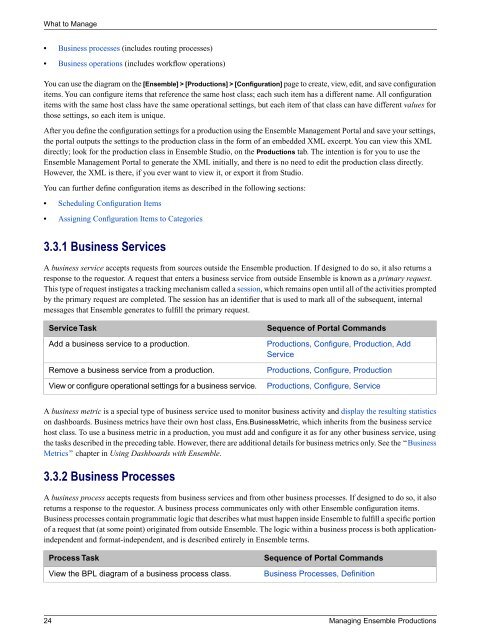Managing Ensemble Productions - InterSystems Documentation
Managing Ensemble Productions - InterSystems Documentation
Managing Ensemble Productions - InterSystems Documentation
You also want an ePaper? Increase the reach of your titles
YUMPU automatically turns print PDFs into web optimized ePapers that Google loves.
What to Manage<br />
• Business processes (includes routing processes)<br />
• Business operations (includes workflow operations)<br />
You can use the diagram on the [<strong>Ensemble</strong>] > [<strong>Productions</strong>] > [Configuration] page to create, view, edit, and save configuration<br />
items. You can configure items that reference the same host class; each such item has a different name. All configuration<br />
items with the same host class have the same operational settings, but each item of that class can have different values for<br />
those settings, so each item is unique.<br />
After you define the configuration settings for a production using the <strong>Ensemble</strong> Management Portal and save your settings,<br />
the portal outputs the settings to the production class in the form of an embedded XML excerpt. You can view this XML<br />
directly; look for the production class in <strong>Ensemble</strong> Studio, on the <strong>Productions</strong> tab. The intention is for you to use the<br />
<strong>Ensemble</strong> Management Portal to generate the XML initially, and there is no need to edit the production class directly.<br />
However, the XML is there, if you ever want to view it, or export it from Studio.<br />
You can further define configuration items as described in the following sections:<br />
• Scheduling Configuration Items<br />
• Assigning Configuration Items to Categories<br />
3.3.1 Business Services<br />
A business service accepts requests from sources outside the <strong>Ensemble</strong> production. If designed to do so, it also returns a<br />
response to the requestor. A request that enters a business service from outside <strong>Ensemble</strong> is known as a primary request.<br />
This type of request instigates a tracking mechanism called a session, which remains open until all of the activities prompted<br />
by the primary request are completed. The session has an identifier that is used to mark all of the subsequent, internal<br />
messages that <strong>Ensemble</strong> generates to fulfill the primary request.<br />
Service Task<br />
Add a business service to a production.<br />
Remove a business service from a production.<br />
View or configure operational settings for a business service.<br />
Sequence of Portal Commands<br />
<strong>Productions</strong>, Configure, Production, Add<br />
Service<br />
<strong>Productions</strong>, Configure, Production<br />
<strong>Productions</strong>, Configure, Service<br />
A business metric is a special type of business service used to monitor business activity and display the resulting statistics<br />
on dashboards. Business metrics have their own host class, Ens.BusinessMetric, which inherits from the business service<br />
host class. To use a business metric in a production, you must add and configure it as for any other business service, using<br />
the tasks described in the preceding table. However, there are additional details for business metrics only. See the “Business<br />
Metrics” chapter in Using Dashboards with <strong>Ensemble</strong>.<br />
3.3.2 Business Processes<br />
A business process accepts requests from business services and from other business processes. If designed to do so, it also<br />
returns a response to the requestor. A business process communicates only with other <strong>Ensemble</strong> configuration items.<br />
Business processes contain programmatic logic that describes what must happen inside <strong>Ensemble</strong> to fulfill a specific portion<br />
of a request that (at some point) originated from outside <strong>Ensemble</strong>. The logic within a business process is both applicationindependent<br />
and format-independent, and is described entirely in <strong>Ensemble</strong> terms.<br />
Process Task<br />
View the BPL diagram of a business process class.<br />
Sequence of Portal Commands<br />
Business Processes, Definition<br />
24 <strong>Managing</strong> <strong>Ensemble</strong> <strong>Productions</strong>

















